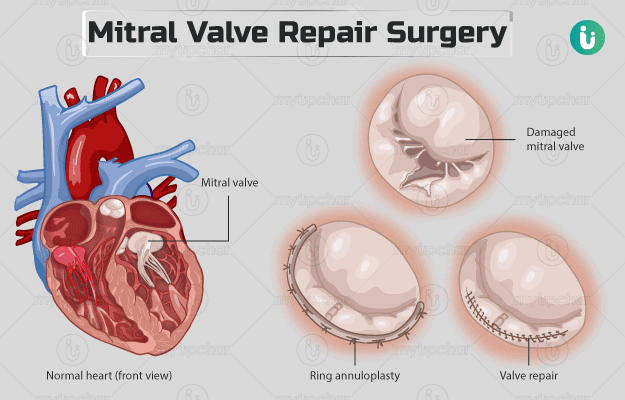
The mitral valve is a left sided valve that is present between the left atrium or collecting chamber and the left ventricle or the pumping chamber. It is made of two leaflets suspended like a parachute by chords attached to the heart muscle.
The valve is commonly affected by degenerative disease in the west and by rheumatic heart disease in the developing world. Previously surgeons used to replace the valve and now the trend is more towards retaining what God’s given us and to repair as far as possible.
Mitral valve repair surgery is now a reality for most type of diseases and has good long term results. The major advantage of this being that by retaining native tissue we avoid the need for anticoagulation. The operation has the same longevity as valve replacement surgery and costs much less. The different types of mitral valve repair surgery are as follows:
- Posterior quadrangular resection:
- Posterior quadrangular resection:
- Goretex chord implantation:
- Pericardial patch augmentation:
- Commissurotomies / commisuroplasties:
- Ring Annuloplasties:
1,2 and 3 are majorly used for degenerative disease of the valve where the leaflets are very large and ballooning out. They are trimmed to size and valve remodeled. While 3,4 and 5 are tailored more for rheumatic mitral valve disease. Mitral valve replacement is a low risk operation and is used nowadays only when an attempt to repair has failed and not as the first choice. The choice of valve depends on the age and needs of the patient.




The mitral valve is very user friendly and can be approached in multiple ways making it a good valve to access with very small incisions, endoscopically, robotically. The different ways of doing mitral valve surgery are as follows.
- Lower partial sternotomy:
The lower end of the chest bone is divided for a length of 5-6 cms and the heart accessed through this. The mitral valve can be repaired or replaced easily through this incision which is preferred due to its cosmetic benefits in addition to the fact that it is less painful and less prone to infections. - Upper partial sternotomy:
The upper part of the chest bone is divided for a length of 5- cms and the heart access as in an aortic valve from the top. It also has good visibility and most mitral valve surgery can be done through this. The disadvantage is that it may show when a female wears a low rising dress - Mini thoracotomy:
The valve can also be accessed with a small 6cm incision either on the right or left chest. The right side is commonly used for first time cases and gives good access. It is cosmetically a superior incision and rest of the advantages are similar. - Endoscopic mitral valve surgery:
Through a right minithoracotomy with a smaller incision one can with the help of an endoscope( camera stick) visualize the valve well and do most repair surgery easily. The advantage of using the endoscope is that we stretch the incision less and the pain is almost nil. Patients get discharged in 48 hrs after surgery. - Robotic mitral valve surgery:
The latest in our armamentarium of procedures. It is very doable and is being done on a regular basis in the western world. It is almost painless and recovery is exceptionally fast. Good patient compliance the only hitch is the cost factor.
BestHeartSurgery is a comprehensive information portal that gives both the common man and medical professionals.

